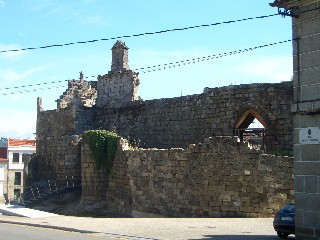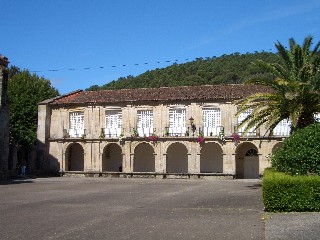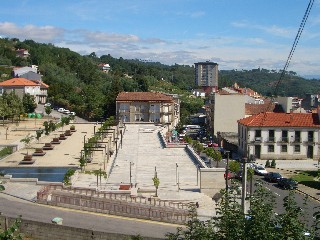Ribadavia
The first time that we Visited Ribidavia it was a last minute decision and we stopped there more as a driving break on route to see a castle at Monterrei than anything else – the decision turned out to be one of our better choices and it has become one of our favourite Galician towns.
Ribadavia is a beautiful town 30 minutes from the city of Ourense in the heart of inland
 Galicia and it has one of the biggest and best medieval quarters of any town in the region. It lies off either the N-120 or the A-52 highways and has a population of around 6000 inhabitants.
Galicia and it has one of the biggest and best medieval quarters of any town in the region. It lies off either the N-120 or the A-52 highways and has a population of around 6000 inhabitants.
When we entered the town the building that first caught our eye was the ruin of an old castle, for which guided tours (arranged through the tourist office) take place every 30 minutes. But it is the old district that falls away on an incline behind this castle that is Ribadavia’s main prize.
It starts when you get to the prazo de maior (or main square), a stunning plaza lined on all sides by old buildings featuring galleria balconies and colonnaded walkways, and continues as you follow the various narrow streets that lead to both the new town and an old Jewish quarter.
Getting to Ribadavia involves a long drive if you are based in Santiago de Compostela and it
 is perhaps more somewhere to consider visiting if you are staying at the southern end of Galicia near Pontevedra or Vigo. If that is the case, it will act to punctuate a journey between either of these localities and Ourense city. That said, it is equally worthy of a visit in its own right, however you need to allow plenty of travelling time and, if you take the faster toll roads, some extra cash.
is perhaps more somewhere to consider visiting if you are staying at the southern end of Galicia near Pontevedra or Vigo. If that is the case, it will act to punctuate a journey between either of these localities and Ourense city. That said, it is equally worthy of a visit in its own right, however you need to allow plenty of travelling time and, if you take the faster toll roads, some extra cash.
Driving into the town of Ribadavia takes you up a hill where you encounter two stone churches (one behind the other).These churches lay to the right of your route and the old castle is situated to your left.
There is plenty of on-street parking in this area and one of the town's two tourist offices lies opposite and slightly above these two churches. This is the point from which we (and we would recommend anyone else) start an exploration of Ribadavia.

A brief history of Ribadavia
Ribadavia is the unofficial capital of a sub-region of Galicia often referred to as Ribeiro (as in the wine). The town is at the junction of two rivers, the Mino and the smaller Avia and it is thought that a Roman village once existed at this point of convergence.
The Ribeiro wine, famous throughout Spain, is now gaining a slightly greater following in the rest of the world and it is Ribadavia that acts as the commercial centre for its produce with many of the important bodegas surrounding the town.
Unfortunately, promotion of this denomination is still rather lacking as our page on Ribeiro wine will explain.
Left, one of the churches on the edge of the old town close to the castle ruin.
A settlement of some sort has been present on the land now occupied by Ribadavia for centuries, but it was not until 1164 that the town was formally recognised and given Royal charter.

Monastic influences saw Ribadavia prosper over the subsequent centuries and as its wine production and that of the surrounding areas increased, it became an economic strong point of the otherwise poor Ourense province.
By the sixteenth and seventeenth centuries the locality has built a high reputation for its wine and the wealth that resulted probably explains why the old town has so many valuable buildings from this and earlier periods. A more recent landmark date for the town was 1947 when it had national monument status declared on its old quarter.
Another unusual feature of Ribadavia is its historic Jewish connection. During the medieval period the town had a very large Jewish population and its own distinct Jewish quarter. Even today, symbols and emblems of this heritage can still be found on buildings around the old town.

The photo above right shows one of the many narrow, winding and sloping streets in the old district and Jewish quarter.

